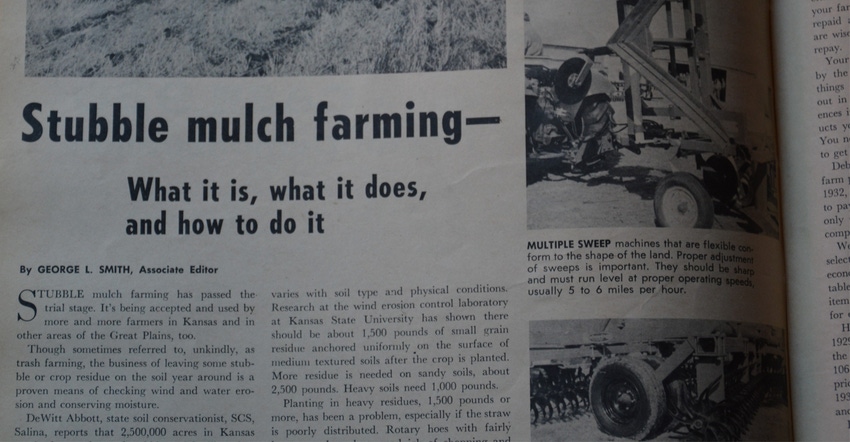July 15, 2019

The benefits of no-till farming were being explored 55 years ago back in August of 1964, though a name had not quite stuck. The Aug. 1 issue of Kansas Farmer called it “stubble mulch farming,” and noted that it was also sometimes referred to as “trash farming.”
Conservationists were recommending the method as a way to check wind and water erosion and conserve moisture by keeping a layer of cover of the ground all year long. Kansas State University was experimenting with how much residue produced the best results at the Sandyland Experiment Field at St. John.
The stubble mulching technique, much like minimum tillage today, utilized an undercutting tool, followed by a sweep to shape the land and a mulch treader to smooth the surface, kill small weeds and scatter bunched residue.
75 years ago
It was in August of 1944 that turkey hatching eggs were shipped commercially by air for the first time in the U.S.
One hundred eggs were removed from an incubator in Worthington, rushed to the Sioux City airport and flown to a Los Angeles hatchery, where the incubation was completed.
The shipment was made on a non-priority basis and carried in a routine manner by Mid-Continent Airlines form Sioux City to Omaha, and then by United Air Lines from Omaha to Salt Lake City to Los Angeles. They were shipped in a regulation egg case.
After hatching, the poults were flown back to Sioux City and transported to Worthington, where they were placed on a feedlot and their development observed. The idea was to extend the reach of Midwestern turkey production around the world.
35 years ago
In August of 1984, after a summer of severe flooding in June and July, farmers were asking a question that has a familiar ring in 2019: was there a way to prevent flooding damage?
The Kansas Soil Conservation Service estimated that about 60% of the $38 million in agricultural damage could have been prevented if all the economically feasible conservation treatments had been in place.
Lowell Abeldt, president of the Kansas Association of Watershed Districts, said the state had budgeted about $2 million a year for dam construction and upland conservation treatments, and it was still not enough. He said the new state water plan might make that $3 million a year with regular increases.
20 years ago
The ever-elusive hybrid wheat was a goal back in August of 1999, with HybriTech U.S., a unit of Monsanto, sharing its dreams for Quantum Plus. The goal was 7 million bushels produced on 100,000 acres.
Goerzen is executive director of the Old Cowtown Museum in Wichita.
About the Author(s)
You May Also Like




